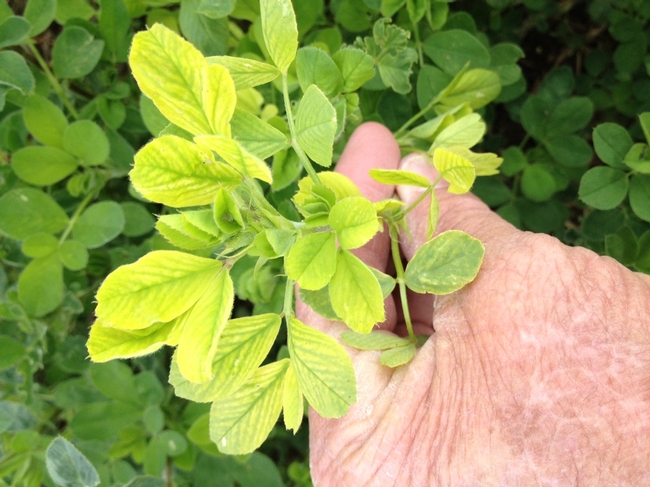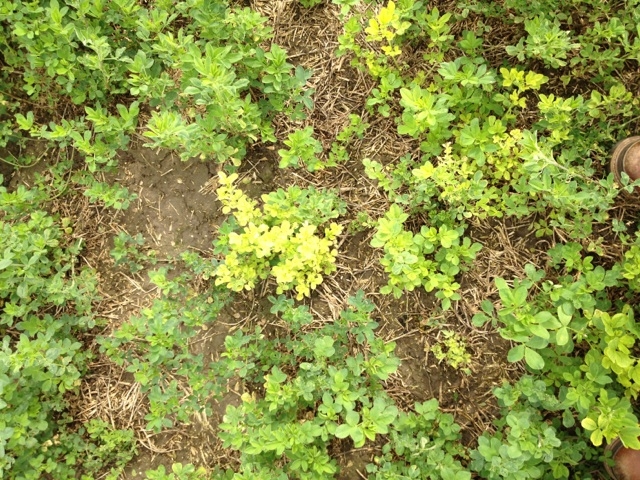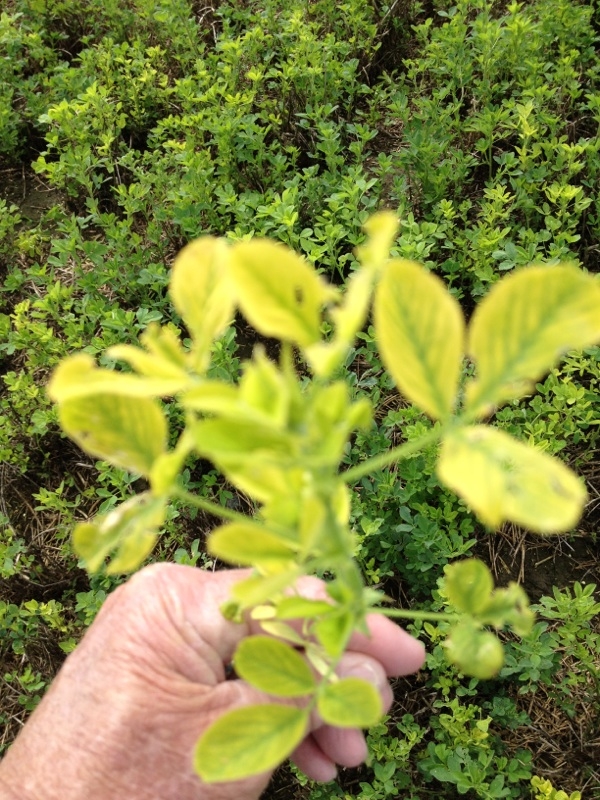- Author: Daniel H Putnam
- Author: steve orloff
A friend sent me these photos from an alfalfa field near the Merced area in California's Central Valley. Can you diagnose what this is?
We're not 100% sure what it is, but have a pretty good idea- and have provided a view at the end of this blog - but see if you can diagnose this yourself.
Here are a few hints:
- Symptoms appeared several weeks ago, in February/March, 2014
- This field had been irrigated twice during winter time due to the drought this year, followed by late Feb early March rains
- These are quite heavy clay-loam soils
- The pH of the soil is rather high, probably 7.5 to 8.2
- Symptoms were generally widespread across the field
- 2-year old stand
- Has been making over 10 tons/acre last few years.
- Lime was applied along with 1,000 lbs of Sulfur
- Variety is Desert Sun (Roundup Ready)
Before you jump in, you might want to see the excellent program Steve Orloff, Steve Norberg, Tim Hays and others put on at the 2013 Western alfalfa symposium in Reno. The subject was "Diagnosing Problems in the Field" The link is: http://lecture.ucanr.org/Mediasite/Play/ecdf9c44db224eba9745559f45f24b381d
All the videos and written material from this conference can be seen at: http://alfalfa.ucdavis.edu/+symposium/2013/index.aspx
Check it out. The videos are great.
Biotic or Non-Biotic?
One of the things they ask you to do is determine whether it's a biotic or a non-biotic problem (e.g. from a pest or a non-pest problem, like cold or soil nutrients).
In this case (above), we note that the yellowing is inter-veinal, not patchy (like an insect or fungus), and it is pretty widespread. So the yellowing does not appear biotic in origin. So, what could it be?
Here are some possibilities:
- Nitrogen deficiency (yellowing causes yellowing symptoms such as this)?
- Sulfur deficiency (also a yellowing of foliage)?
- Virus infection (also causes a yellowing)?
- Micronutrient deficiency (Fe) also causes a yellowing
- Excess moisture/lack of oxygen causes yellowing
Fe Deficiency. Now, we may need a little more information to eliminate all of these possibilities - but our guess is that this type of yellowing is due to excess water in the heavy soil. This causes lack of oxygen, which creates a 'reducing' soil environment, which makes iron and other micronutrients unavailable--leading to iron chlorosis. High pH may make this worse. I'm not sure why the lime was applied, since the soil is high in pH.
It's also a possibility that biological N2 fixation has been compromised by the wet soils, leading to N deficiency - but I doubt it since usually this is a different pattern of yellowing - whole leaf.
Some further soil and plant samples may give us further clues as to whether we are correct.
What is the solution? There's a good chance that nothing is needed and the situation will improve on its own. Good drainage is critical. Usually as air temperatures warm and the soil dries and aeration improves, the problem is likely to correct itself. The same is generally true with N deficiency, that is if the bacteria is present for re-inoculation - the plants turn green again when the weather warms up and drainage occurs, if there is rhizobium bacteria available.
While it is difficult to predict the weather and rain events, it is especially important to avoid over-irrigation on these types of soil (heavy soils with a high pH and slow drainage).
If we get further information to confirm (or contradict) our diagnoses, we'll let you know.







My vote is too much water.
It's ironic (get it) that this occurred due to EXCESS moisture in a drought year.
Vern, what were the iron concentration in a tissue test?
I though it was caused by high calcium levels. After all the soil here is calcareous, with an 8 pH, 8,500 ppm Ca, Plus 4% to 6% free lime.
Then Matt Hagny mhagny@cox.net a crop consultant up in the Western Corn Belt explained the function of calcium bicarbonate.
on occasion alfalfa or bermudagrass will have a tissue analysis of 300 or 400 ppm Fe, though the usual is in the 100 ppm range. HERE we seldom have visual signs of iron chlorosis in our field crops. Yard fruit trees are a different matter. Peach and pair trees suffer with iron chlorosis no matter hoow much iron is dumped into the ground or sprayed on the leaves.
To add to the excitement we have high shrink clay soil.
Work with the soil and forget Virginia garden soils will save our sanity.